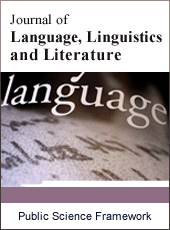Journal of Language, Linguistics and Literature
Articles Information
Journal of Language, Linguistics and Literature, Vol.1, No.2, Apr. 2015, Pub. Date: Apr. 10, 2015
Theories of First Language Acquisition
Pages: 30-40 Views: 11119 Downloads: 100418
[01]
Saeed Mehrpour, Department of Foreign Languages & Linguistics, Shiraz University, Shiraz, Iran.
[02]
Ali Forutan, English Department, Farhangian University of Isfahan, Isfahan, Iran.
Investigating the processes through which individuals acquire language is Language acquisition. In general, acquisition of language points to native language acquisition, which examines children’s acquisition of their first language, while second language acquisition concerns acquisition of extra languages in children and adults as well. The history of language learning theories can be considered as a great pendulum cycled from Skinnerian environmentalism to Piagetian constructivism to Chomskian innatism. Consequently, much of research in this field has been revolved around the debates about whether cognitive process and structure are constrained by innately predetermined mechanism or shaped by environmental input. Linguists Noam Chomsky and Eric Lenneberg, for half a century have argued for the hypothesis that children have inborn, language-specific capabilities that make possible and restrict language learning. Others, like Catherine Snow, Elizabeth Bates and Brian MacWhinney have hypothesized that language acquisition is the product of common cognitive capacities and the interface between children and their surrounding communities. William O'Grady suggests that multifaceted syntactic phenomena stem from an efficiency-driven, linear computational system. O'Grady refers to his work as "nativism without Universal Grammar. Nevertheless, these basic theories of language acquisition cannot be absolutely divorced from each other. The purpose of the present paper is reviewing some of the fundamental theories that describe how children acquire their native language. Therefore describing the strengths and weaknesses of Behaviorism, Mentalism, Rationalism, Empiricism, Emergentism, Chunking, Vygotsky’s Sociocultural Theory, Piaget’s theory of child language and thought, Statistical Language Learning, Relational Frame Theory and Activity theories are among the objectives of this study. In general these basic theories are very much complementary to each other, serving different types of learning and indicating diverse cases of language learning.
Behaviorism, Mentalism, Rationalism, Empiricism, Emergentism, Sociocultural Theory
[01]
Belmont, CA: Wadsworth, Cengage Learning. pp. 67–77, 88–100. ISBN 13:978-1-13 3-31624-4.
[02]
Bickerton, D. (1990). Language and Species. Chicago: University of Chicago Press.
[03]
Bloom, L.M. (1974). "Imitations in Language Development: If, When, and Why", Cognitive Psychology, pp. 380-420.
[04]
Brown, D. H. (2000). Principles of Language Learning and Teaching. (4th edition). NY: Longman
[05]
Chase, W. G., & Simon, H. A. (1973). Perception in chess. Cognitive Psychology, 4, 55- 81.
[06]
Elman, J. L. & Bates, E. A. (1997). Response to ‘Little Statisticians’. Science, 276(5315), 1161-1300.
[07]
Elman, J. L. (1999). The emergence of language: A conspiracy theory. In MacWhinney, B. (Ed.), The emergence of language (pp. 1-28). New York: Harper Collins.
[08]
Foley, J. & Thompson, L. (2003). Language learning: A lifelong process. London: Arnold.
[09]
Ghasemzadeh, H. (2005). Vygotsky’s Mediational Psychology: A New Conceptual of culture, Signification and Metaphor. Language Science 27, 281-300.
[10]
Graf-Estes, K., Evans, J. L., Alibali, M., & Saffran, J. R. (2006). Can infants map meaning to newly segmented words? Statistical segmentation and word learning. Psychological Science, 18(2), 254-260.
[11]
Jones, Hubbard and Thornton Wheeler (1983). A Training Course for TEFL. Oxford University Press.
[12]
Karmiloff, K. & Karmiloff-Smith, A. (2002). Pathways to Language: From fetus to adolescent. Cambridge: Harvard University Press.
[13]
Kim, R., Seitz, A., Feenstra, H., & Shams, L. (2009). Testing assumptions of statistical learning: Is it long-term and implicit? Neuroscience Letters, 461, 145-149.
[14]
Lantolf, J. P. (2007). Sociocultural Theory and Second Language Learning. Oxford: Oxford University Press.
[15]
Lightbown, P, M. and Spada, N. (2000). How languages are learned. Oxford: Oxford University Press.
[16]
Lightbown, P.M., Spada, N. (2006). How Languages are Learned. OUP.
[17]
MacWhinney, B. (2005). The Emergence of Grammar from Perspective. In Pecher, D. & Zwaan, R. (Eds.), Grounding Cognition: The Role of Perception and Action in Memory, Language and Thinking (pp. 198-223). Cambridge, UK: Cambridge University Press.
[18]
Mathy, F., & Feldman, J. (in review). What’s magic about magic numbers? Chunking and data compression in short-term memory. Retrieved 18 January 2011 from http://slhs.univ-fcomte.fr/rech/psycho/filesMathy/MathyFeldmanChunking.pdf.
[19]
Miller, G. A. (1956). The magical number seven, plus or minus two: Some limits on our capacity for processing information. Psychological Review, 63, 81-97.
[20]
Newell, A. (1990). A unified theory of cognition. Cambridge, MA: Harvard University Press.
[21]
Newman, F. & Holtzman, L. (2005). Lev Vygotsky: Revolutionary Scientist. NY: Routledge Publications.
[22]
Newport, E. L. (1988). Constraints on learning and their role in language acquisition: Studies of the acquisition of American Sign Language. Language Sciences, 10, 147–172.
[23]
Newport, E. L. (1990). Maturational constraints on language learning. Cognitive Science, 14, 11–28.
[24]
O’Grady, W. (2007a). Emergentist program. Available at: http://www.ling.hawaii.edu/faculty/ogrady/.
[25]
Osgood, C. E. (1957). A behavioristic analysis of perception and language as cognitive phenomena. In J. S. Bruner (Ed.), Contemporary approaches to cognition (pp. 75-117). Cambridge, MA: Harvard University Press.
[26]
Peters, A. M. (1983). The units of language acquisition. Cambridge: Cambridge University Press.
[27]
Rivers, M. Wilga (1968). Teaching Foreign Language Skil1s. Chicago: Chicago University Press.
[28]
Saffran, J. R., Aslin, R. N., & Newport, E. L. (1996). Statistical learning by 8-month-old infants. Science, 274, 1926-1928.
[29]
Schultz, D. P.; Schultz, S. E. (2012). A history of modern psychology (10th ed.).
[30]
Tomasello, N. (1992). First verbs: A case study of early grammatical development. Cambridge, UK: Cambridge University Press.
[31]
Vygotsky, L. (1986). Thought and Language. Cambridge, MA: MIT Press.

ISSN Print: 2381-7054
ISSN Online: 2381-7062
Current Issue:
Vol. 6, Issue 1, March Submit a Manuscript Join Editorial Board Join Reviewer Team
ISSN Online: 2381-7062
Current Issue:
Vol. 6, Issue 1, March Submit a Manuscript Join Editorial Board Join Reviewer Team
| About This Journal |
| All Issues |
| Open Access |
| Indexing |
| Payment Information |
| Author Guidelines |
| Review Process |
| Publication Ethics |
| Editorial Board |
| Peer Reviewers |


